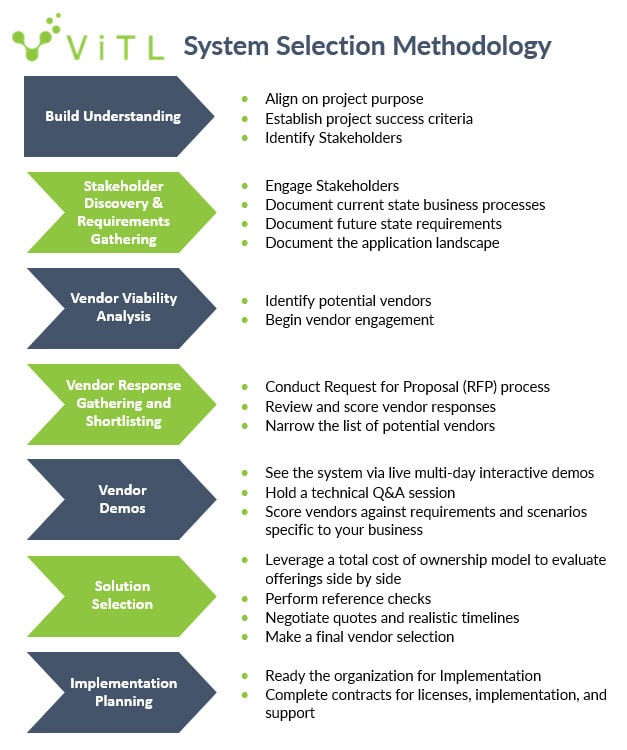Hint: It’s not just selecting the system
In this article we break down what is required to conduct a detailed system selection project and describe the approach, resources, and timeline required. In recent articles we reviewed the risks of skipping a detailed system selection project, ways that a detailed system project will set you up for implementation success, and indicators that you will benefit from a detailed system selection project. Now, we will dig into the “How” so that when you start a detailed System Selection project (either with your own employees or with contracted resources), you can go in with eyes wide open.
What does it take to do a Detailed System Selection Project?
A detailed System Selection project is just that … a project! Doing it correctly requires a structured approach, proper resource allocation, and time. Luckily, when done correctly, the investment will be regained during system implementation.
A Structured Approach
ViTL’s System Selection Methodology was formed by combining employee’s past experiences managing System Selection and then right sizing the approach to bring the most value to our clients faster. The process involves 7 phases that are focused not only on system selection but also on setting you up for a successful implementation. The phases can be summarized as follows:
Build Understanding: The process begins with a well-defined business case and early engagement of stakeholders. Once complete, the business case (which defines the project’s importance) along with the project approach and necessity of stakeholder involvement is shared at a project kickoff.
Stakeholder Discovery and Requirements Gathering: Then, through stakeholder interviews, requirements and current state processes are gathered at both the high and medium level¹. With a focus on the future: Requirements are a mix of core business needs and future desires; The current state is documented so that vendors can propose a future state with the out of the box solution and not miss core business objectives.
Vendor Viability Analysis: In parallel, vendor viability is conducted to identify prospect software vendors and determine who will be invited to propose a solution.
Vendor Response Gathering and Shortlisting: The requirements and current state processes are packaged with a Request for Proposal (RFP), and based on vendor’s RFP responses, 2-4 vendors are invited to demo.
Vendor Demos: Demos are multi-day, live, and interactive. The vendor demos are based on their ability to meet your requirements (one by one) and a wide audience of stakeholders attend and score the vendors’ demos. A special session technical Q&A is also held with IT stakeholders.
Solution Selection: With RFP responses, initial quotes, and demo scores in place, a detailed side by side comparison of each vendors’ capabilities are conducted. This also involves reference checks and a deeper review of the implementation proposal and timeline. A total cost of ownership model is in place, and negotiations are conducted from a position of strength enabling both short- and long-term savings. The organization then selects a system with confidence knowing it is the best system for their organization.
Implementation Planning: A small gap should be planned between solution selection and Implementation which allows vendors to assign resources to the project. During this time, implementation planning is done to ready the organization for the large initiative. This involves preparing the organization with expectations and lining up internal resources to support. Additionally, there may be work finalizing contracts and obtaining software licenses.

¹ The medium level for requirements and process documentation is relatively detailed; Low level refers to click by click processes and field drop down definitions which should wait until system implementation.
Resource Allocation
For a System Selection project to be done efficiently a dedicated lead and a skilled business analyst (or two) are required. For a System Selection project to be done well, high stakeholder engagement and active sponsorship are a must.
System Selection Lead: This resource should have a solid foundation in project management with leadership skills to corral stakeholders, vendors, and decision makers. This person will be primary for driving activities, ensuring quality, adhering to the system selection timeline, and creating presentations that enable system selection. Ideally this person also has system selection and system implementation experience.
Business Analyst(s): Depending on the project complexity and timeline you may require one or two business analysts. System selection is a documentation heavy process and the investment in documentation here will save you time in implementation (reducing planning and design duration during implementation). The ideal resource for this role is detail-oriented and has a strong business analyst skillset that includes note taking, process flow mapping, light financial analysis, light data management skills, requirements documentation experience, and ability to assist with vendor communications and logistics.
Stakeholders: Stakeholder engagement is required throughout the system selection process. Stakeholders are responsible for representing their department’s interest: defining requirements, providing their current state processes, evaluating the vendor’s ability to meet their specific requirements, and providing input into the overall selection.*
Project Leader: This person provides day to day decision making on the direction of the project and is the first point of contact for the System Selection Lead.*
System Selection Steering Committee: This group will ultimately make the system selection decision. Ideally, this group meets every few weeks to monitor progress and contribute to the process.
Executive Sponsor: This person drives the overall direction of the project, makes decisions on vendor communications, chairs the System Selection Steering Committee, and ensures budgetary expectations are set with executives.
*On most weeks, Stakeholders and the Project Leader should plan 2-4 hours of project support.
Time
Realistically, vendor selection will require about one quarter to complete when there is proper resource allocation and adherence to a methodology.
Below is a Sample System Selection Timeline of a three-and-a-half-month project, where the selection is completed at the end of month three.

The timeline can be shortened by:
- Ensuring there is adequate business analyst support for the “Stakeholder Discovery and Requirements Gathering” phase as well as the “Vendor Response Gathering and Shortlisting” phase where documentation needs tend to be heavy
- Initiating the project with a well curated group of engaged stakeholders to ensure comprehensive coverage and subject matter expertise is available from the beginning
- A structured vendor pricing review process that supports prompt negotiations
- A consistently engaged System Selection Steering Committee empowered to make a selection and approve spending for the system and implementation contracts
In our next article we will be looking at the Business Case associated with conducting a detailed System Selection Project. If you are preparing to recommend a detailed System Selection project this next article will be for you. If you are seeking this knowledge now, reach out to us.



